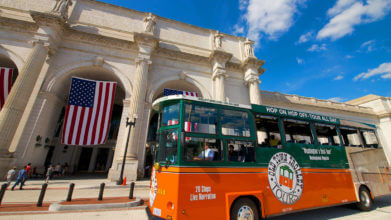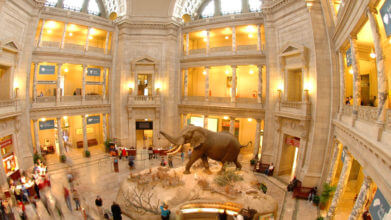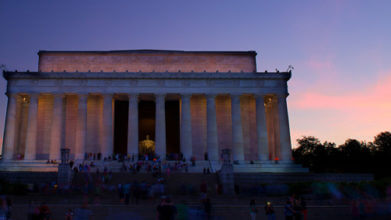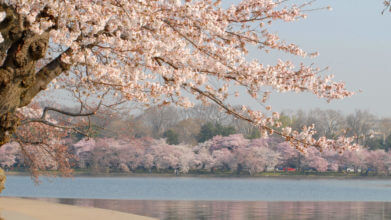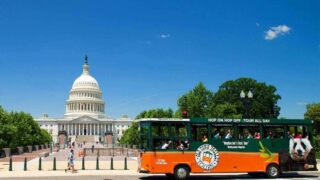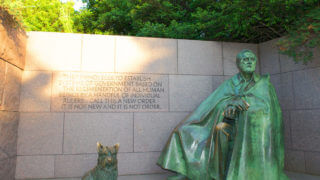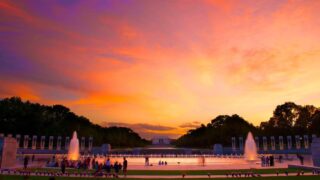A Visitor’s Guide to the Jefferson Memorial
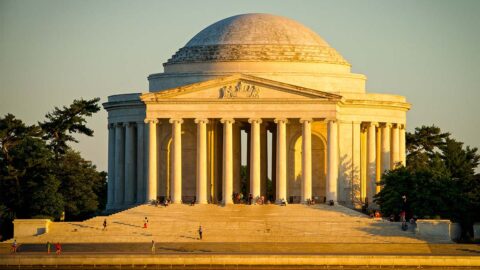
Tours in Washington, DC, are not complete without a stop at the Jefferson Memorial. A tribute to the third president of the United States, Thomas Jefferson, the memorial stands as a recognized symbol of democracy and independence. As one of the founding fathers of the country and the author of the Declaration of Independence, Jefferson’s significant impact on the shaping of the U.S. government is known throughout the world. Visiting this iconic site offers a unique opportunity to connect with the ideals that have shaped American democracy.
Inside the memorial sits a 19-foot statue of Jefferson surrounded by passages from the Declaration of Independence and other key writings inscribed on the walls. The beautiful white-domed building is completely open to the elements and is situated on the Tidal Basin, framed by blooming cherry blossom trees in the spring. With its messages of hope and freedom, stunning views, and rich history, the Jefferson Memorial is truly a sight to be seen for visitors to Washington, DC.
The Definitive Guide to Visiting the Jefferson Memorial
The Jefferson Memorial, a stunning tribute to the third U.S. President and author of the Declaration of Independence, is a centerpiece of the Tidal Basin and the National Mall. The most convenient, stress-free, and informative way to visit this iconic structure is with Old Town Trolley Tours. The hop-on, hop-off service delivers you directly to the memorial while providing expert historical context, ensuring you maximize your visit.
Why Choose Old Town Trolley Tours
- Direct Stop: The Jefferson Memorial is a dedicated stop (Stop 8) on the main Old Town Trolley Tours route, placing you steps from the entrance.
- Avoid Parking and Walking: The trolley eliminates the need for expensive parking or the exhaustive walk from other parts of the National Mall.
- Best Tidal Basin Access: The stop provides immediate access to the scenic walking path around the Tidal Basin, which is famous for the blooming Cherry Blossoms each spring.
- Expert Live Narration: The certified, knowledgeable conductors deliver a fascinating 100% live narration about Thomas Jefferson’s life, the memorial’s history, and the surrounding monuments.
- Seamless Monument Connections: he route connects the Jefferson Memorial directly to the Martin Luther King Jr. Memorial and the Franklin Delano Roosevelt Memorial, which are also located along the Tidal Basin.
Jefferson Memorial Visitor Information
The Old Town Trolley Tours stop enables you to fully appreciate the features of the memorial and its stunning location.
- Admission is Free: There is no entrance fee to visit the Jefferson Memorial, and it is open to the public 24 hours a day.
- Witness Neoclassical Grandeur: The memorial’s beautiful white-domed structure was inspired by the Pantheon in Rome and the Rotunda at the University of Virginia (which Jefferson designed).
- See the 19-Foot Bronze Statue: Inside the memorial stands a 19-foot bronze statue of Jefferson, surrounded by passages from the Declaration of Independence and other key writings.
- Visit During the Cherry Blossoms: The memorial is situated on the Tidal Basin, which is famously framed by blooming cherry trees in the spring, offering stunning views and photo opportunities.
- Access is Seamless with Old Town Trolley Tours: The Old Town Trolley includes a stop at the Jefferson Memorial, making it convenient to hop on and off to visit nearby landmarks like the Franklin Delano Roosevelt Memorial and the Martin Luther King Jr. Memorial.
History of the Jefferson Memorial
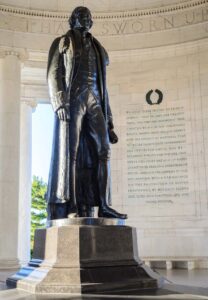 The Jefferson Memorial, a monument dedicated to Thomas Jefferson, the third president of the United States, is situated in West Potomac Park on the south bank of the Tidal Basin. Authorized in 1934 as part of a beautification program for the nation’s capital, its construction was initially met with some controversy. Many modernist architects, including Frank Lloyd Wright, opposed its Classical design, favoring more contemporary architectural styles. Others objected to the destruction of some cherry trees to make way for the monument, even chaining themselves to the trees in protest. Despite these objections, construction began in 1938 under the encouragement of President Franklin D. Roosevelt, who greatly admired Jefferson. The memorial continued to be built even after the United States entered World War II in 1941, and it was finally dedicated on April 13, 1943, the 200th anniversary of Jefferson’s birth.
The Jefferson Memorial, a monument dedicated to Thomas Jefferson, the third president of the United States, is situated in West Potomac Park on the south bank of the Tidal Basin. Authorized in 1934 as part of a beautification program for the nation’s capital, its construction was initially met with some controversy. Many modernist architects, including Frank Lloyd Wright, opposed its Classical design, favoring more contemporary architectural styles. Others objected to the destruction of some cherry trees to make way for the monument, even chaining themselves to the trees in protest. Despite these objections, construction began in 1938 under the encouragement of President Franklin D. Roosevelt, who greatly admired Jefferson. The memorial continued to be built even after the United States entered World War II in 1941, and it was finally dedicated on April 13, 1943, the 200th anniversary of Jefferson’s birth.
The circular colonnade, designed by John Russell Pope, Otto R. Eggers, and Daniel P. Higgins, drew inspiration from the Pantheon in Rome and the Rotunda at the University of Virginia, which Jefferson himself designed. Situated on 18 acres, the memorial serves as the southern terminus of the north-south axis that includes the White House and the Washington Monument. The pediment above the portico features a depiction of Jefferson reading his draft of the Declaration of Independence. At the center of the domed, marble-lined interior is a 19-foot bronze statue of Jefferson, created by sculptor Rudolph Evans. Surrounding the statue are inscriptions from Jefferson’s most important writings, including the Declaration of Independence, the Statute for Religious Freedom, and several of his letters. Along the frieze inside the dome is a famous quote from Jefferson: “I have sworn upon the altar of God eternal hostility against every form of tyranny over the mind of man.”
Interesting Facts About the Jefferson Memorial
Bronze Statue Replacement
The statue of Jefferson inside the memorial is not the original. During the memorial’s dedication in 1943, the country was heavily involved in World War II, which meant bronze and other metals were prioritized for the war effort. The statue was initially made of plaster and painted bronze. The bronze statue seen today was installed later in 1947, after the war had ended.
FDR’s Vision
President Franklin D. Roosevelt, a great admirer of Jefferson, insisted that the location of the memorial be in its current spot, providing a clear line of sight from the White House. This strategic positioning symbolizes the connection between two great presidents and offers visitors standing on the top step of the Jefferson Memorial a clear view of the White House, creating a powerful visual link between Jefferson’s ideals and the leadership of the nation.
Cherry Tree Rebellion
The Tidal Basin, where the memorial sits, is famous for Washington, DC’s cherry blossoms. The construction of the Jefferson Memorial required the removal of some of these trees, which led to the “Cherry Tree Rebellion.” Around 50 local women protested by chaining themselves to the trees to prevent their removal. While some trees were ultimately cut down, the area around the memorial remains a stunning location for cherry blossoms each spring.
Know Before You Go
Location
The Jefferson Memorial is located on the Tidal Basin in West Potomac Park, providing visitors with stunning views of the water and the surrounding cherry trees. Its position makes it easily accessible from Downtown Washington, DC, and it is close to other iconic landmarks like the Washington Monument and the National Mall. This central location makes it an ideal starting point for those planning to explore more of the city’s rich history and architecture.
Visiting Hours
The Jefferson Memorial is open to the public 24 hours a day, allowing for visits at any time. Visiting at night is particularly special, as the lighting enhances the marble structure’s beauty, creating a serene and memorable experience for visitors. During the day, the sunlight casts beautiful shadows, highlighting the intricate details of the architecture, making each visit unique.
Entry Fee
There is no entrance fee to visit the Jefferson Memorial. Visitors can explore the site freely, whether they wish to take a quick look or spend time reflecting on Jefferson’s legacy. Free access makes it an excellent option for families, solo travelers or anyone looking to experience the cultural richness of Washington, DC, without additional costs.
Transportation
Consider using public transportation to reach the Jefferson Memorial. The nearest Metro station is Smithsonian, which serves the Blue, Orange, and Silver Lines. For those exploring multiple DC attractions, Old Town Trolley Tours® offers a convenient hop-on, hop-off service that includes a stop at the Jefferson Memorial, making it easy to navigate the city while learning about its rich history. The trolley’s engaging narration provides insights into the city’s landmarks, adding depth to your exploration.
Best Time To Visit
Springtime is especially popular at the Jefferson Memorial due to the beautiful cherry blossoms that frame the Tidal Basin. Early mornings or late evenings offer a more peaceful experience, with fewer crowds and a chance to take in the tranquil atmosphere. During autumn, the vibrant foliage surrounding the Tidal Basin provides a different but equally stunning backdrop, perfect for photographs.
Accessibility
The Jefferson Memorial is wheelchair accessible, with ramps available to ensure ease of navigation for all visitors. The site is designed to be inclusive, and the National Park Service provides information on additional accessibility accommodations if needed. Assistance for visitors with visual or hearing impairments is also available, ensuring that everyone can enjoy this historic site.
Photography
The Jefferson Memorial is a photographer’s paradise, offering stunning views both from the memorial itself and the surrounding Tidal Basin. Sunrise and sunset provide ideal lighting for capturing the beauty of the marble structure and its reflections in the water. Photographers will find plenty of opportunities to capture the serene atmosphere, the architecture and the natural beauty that surround this historic site.
Things To Do at the Jefferson Memorial
Visit the Memorial
The Jefferson Memorial is a stunning architectural tribute to Thomas Jefferson, featuring a beautiful white marble structure that is open to the sky. Inside, the 19-foot statue of Jefferson stands as a central focal point surrounded by passages from his most significant writings. As you walk through the space, you’ll gain a deeper appreciation for Jefferson’s role in shaping the principles of democracy that guide the nation today. The peaceful ambiance makes it an excellent place to reflect on the history of the United States.
Stroll the Tidal Basin
One of the most relaxing activities at the Jefferson Memorial is taking a stroll around the Tidal Basin. The walking path offers beautiful views of the memorial reflected in the water, framed by cherry blossoms in the spring. During the summer, the shaded paths provide a cool retreat, while autumn offers a vibrant display of fall colors.
Picnic in the Park
The green spaces surrounding the Jefferson Memorial provide a perfect setting for a picnic. With the Tidal Basin as your backdrop, you can enjoy a leisurely meal while soaking up the views. It’s a great way to spend time with family or friends while enjoying the natural beauty of Washington, DC, and reflecting on the history around you.
Reflect on the Quotes
Inside the Jefferson Memorial, you’ll find excerpts from Jefferson’s writings that emphasize his thoughts on liberty, democracy, and the responsibilities of a free society. Take a moment to read these inscriptions and reflect on their enduring relevance. The quotes remind visitors of Jefferson’s vision and the ideals that have shaped American values for generations. Each passage offers insight into Jefferson’s philosophy and his lasting impact on the nation.
Enjoy the Night Lights
Visiting the Jefferson Memorial after sunset is a magical experience. The soft illumination of the statue and the surrounding columns creates a serene atmosphere, offering a new perspective on this historic site. The reflections on the Tidal Basin’s waters make for a breathtaking sight, making an evening visit highly recommended for anyone exploring Washington, DC. The quiet of the evening adds to the sense of reverence that surrounds this tribute to one of America’s most influential founders.
Nearby Things To Do
Tidal Basin
The Tidal Basin is an iconic part of Washington, DC, known for its stunning cherry blossoms that bloom each spring. A walk around the basin offers picturesque views of the Jefferson Memorial, as well as other nearby landmarks, such as the Franklin Delano Roosevelt Memorial and the Martin Luther King Jr. Memorial. The 2-mile loop around the Tidal Basin provides a refreshing way to enjoy nature while taking in the historical significance of the surrounding monuments.
Franklin Delano Roosevelt Memorial
Situated along the Tidal Basin, this expansive memorial pays tribute to FDR’s four terms as president. It features waterfalls, bronze sculptures and powerful quotes that reflect Roosevelt’s leadership during the Great Depression and World War II. It’s a meaningful stop that complements a visit to the Jefferson Memorial, offering insights into another pivotal figure in American history and his contributions to the country’s progress.
Martin Luther King Jr. Memorial
Located across the Tidal Basin from the Jefferson Memorial, the Martin Luther King Jr. Memorial honors the civil rights leader’s legacy. The powerful stone sculpture of Dr. King, along with inscriptions from his speeches, provides a moving experience and underscores the ongoing pursuit of equality and justice in America. The proximity of these two memorials allows for a reflective journey through the ideals that continue to shape the nation.
International Spy Museum
Just a short distance away, the International Spy Museum offers a unique look into the world of espionage. It’s a fascinating diversion from the historical monuments with interactive exhibits that appeal to both adults and children, making it a great addition to a day of exploring Washington, DC. The museum’s exhibits reveal the secrets behind famous spy missions and offer a hands-on experience that is both entertaining and educational.
FAQs
What is special about the Jefferson Memorial?
The Jefferson Memorial is special because it honors Thomas Jefferson, the third president of the United States and the author of the Declaration of Independence. It celebrates his contributions to the founding of the nation and his belief in the principles of democracy and freedom.
What are the four quotes in the Jefferson Memorial?
The four quotes inscribed inside the Jefferson Memorial come from Jefferson’s most influential writings. They include passages from the Declaration of Independence, emphasizing the rights to life, liberty, and the pursuit of happiness, and the Statute for Religious Freedom, which highlights the importance of separation between church and state. There are also excerpts from his Notes on the State of Virginia and a letter where he speaks against tyranny and supports the idea of government accountability to the people.
What events are held at the Jefferson Memorial?
The Jefferson Memorial hosts a variety of events throughout the year, including ceremonies and gatherings that celebrate important moments in American history. The location is often used for events during Independence Day and Presidents’ Day, as well as other national observances. Additionally, during the annual Cherry Blossom Festival, the memorial becomes a focal point for visitors enjoying the stunning blooms around the Tidal Basin.

